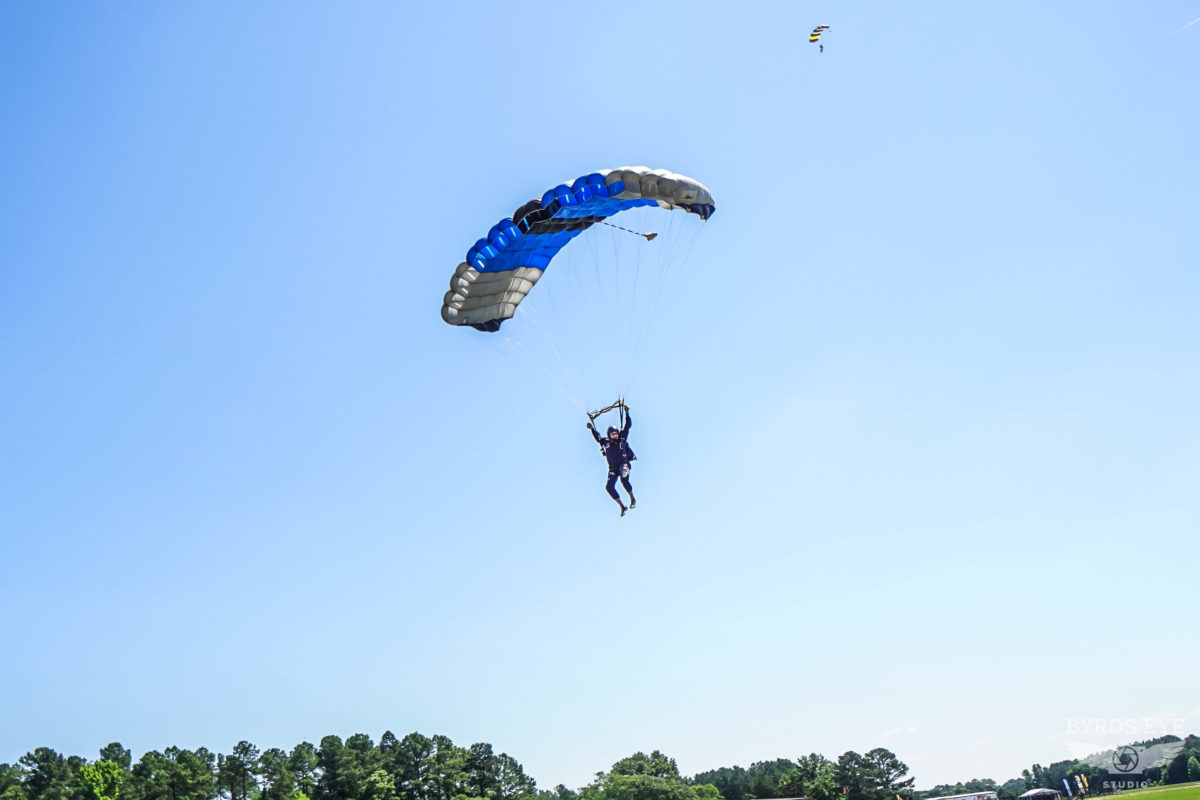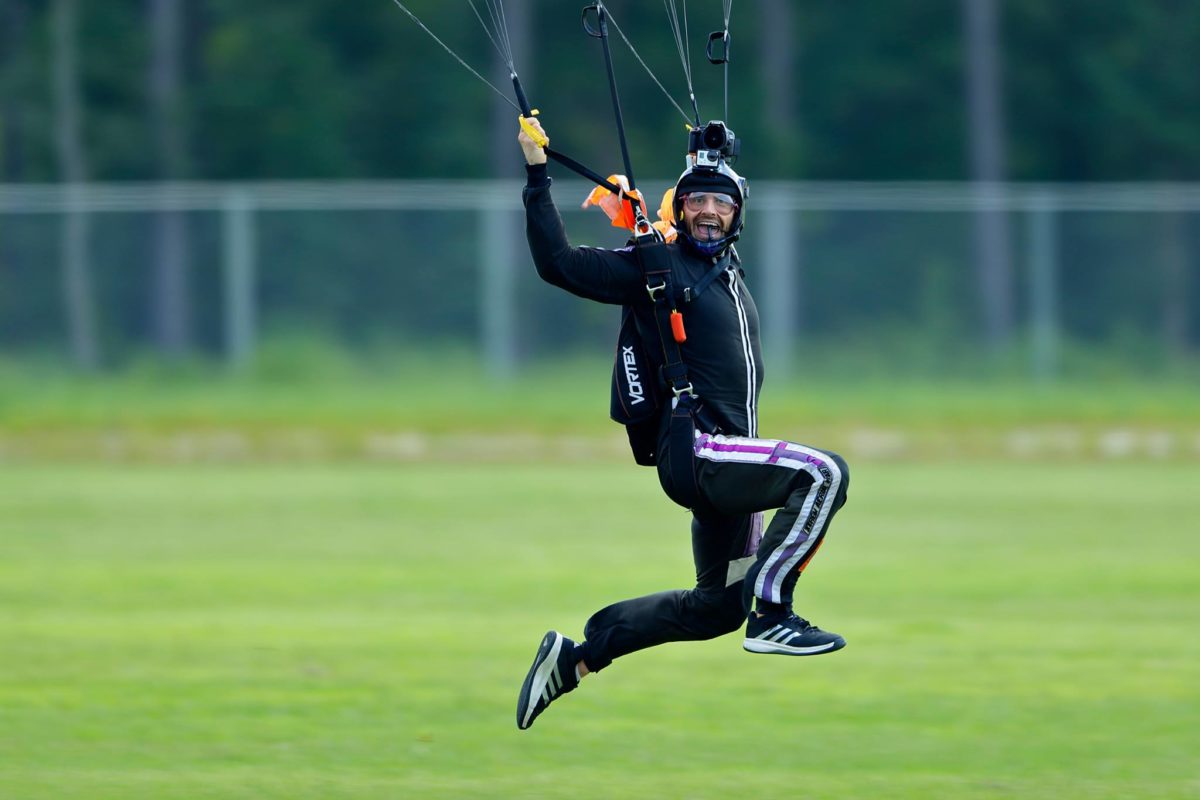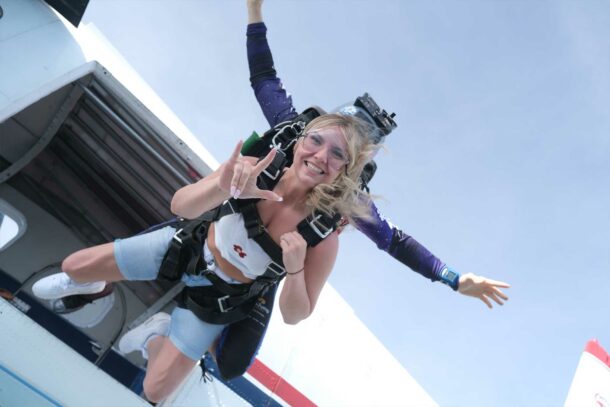Learning How to Fly A Parachute
Friday, July 8, 2022
Flying a Skydiving Parachute
In a let’s-get-to-the-ground-safely-with-no-nifty-tricks sense, flying a parachute is like driving a car. The advanced stuff, like swooping and relative work, is a bit different. But, in general, is flying a canopy super easy? Well, not at first. But is it totally doable? Heck, yes! And despite everyone having a different learning curve, anyone can learn how to fly a parachute.

What is a Parachute?
In skydiving, a parachute (or canopy) is essentially a piece of fabric that fills with air and enables the jumper to slow their rate of descent enough to safely land on the ground below. Parachutes vary in size, shape, and many other characteristics; some are known for snippy turns while others are more docile.
How exactly does a parachute work?
Let’s address how the canopy fills with air.
In skydiving, the parachute is not like a gigantic bed sheet with strings attached; it is essentially two pieces of fabric, attached by sets of ribs. It’s highly engineered with particularly placed holes within the ribs, called cross ports, that are generally a little larger than a softball. The cross ports are located throughout the canopy to inflate the “cells.”
To explain what a cell is like, let’s imagine the Michelin Man or a quilt. You see stitching (ribs), then a puffy part (cell), then stitching … and so on. A canopy will typically have 7 or 9 cells.
Parachute Terminology
Lines
There are lines that run from the container (which is the name of the snazzy skydiving backpack we wear) to the parachute. The lines are insanely durable and constantly inspected (during every pack job) in order to assess their wear and tear. These lines allow the jumper to control (drive) the canopy.
Toggles
A skydiver can’t hold itty bitty lines, so they’ve got handles fastened to them called toggles! The toggles attach to the steering lines – one in the left hand and one in the right – allowing the jumper to precisely control where the canopy flies.
Pulling down on one toggle will cause you to turn in the corresponding direction. You can pull the toggle down in different ways – quickly or slowly, deep or just slightly. Each one of these maneuvers has a different effect on the canopy. Forcing the canopy to turn results in a quicker loss of altitude and a simultaneous increase in speed. Fun!
Since toggle pressure results in turning the canopy, you cannot do this super aggressively near the ground. Small adjustments can be made when coming into land, but nothing too bold.
Flare
Pulling down on both toggles is called a flare. Flaring rapidly decreases the rate of descent and the forward speed to allow for a smooth and soft landing.

Riser
A riser is the material that attaches the harness the jumper wears to the lines. There are four attachment points on the risers, and each corresponds to the lines at the front (nose) or back (tail) of the canopy. Jumpers can use the risers to steer the canopy, and can even land safely on them for practice or in the event that they can’t use their toggles! Neat stuff!
Pilot Chute
The parachute is folded as prescribed and neatly contained with a closing pin. When it’s time to deploy the parachute, the jumper will pull a hackey attached to the pilot chute which in turn pulls the closing pin out of the bundle and, voila, the canopy deploys.
The pilot chute is a small, round piece of fabric that catches the air in order to pull the pin and snatch the canopy out of the container. You’ll see skydivers looking up at this point to make sure their beautiful canopy fully unfurls so they can continue safe descent.
Cutaway
When someone has to cut away their main canopy and deploy their reserve parachute, they are essentially releasing the risers. By mandate, reserves are repacked every 180 days, regardless of whether or not they’ve been deployed. It’s imperative that they’re in tip-top shape so that they are ready to save you in the unlikely event they’re needed.
Skydivers operate with a ‘not if, but when’ mentality. We think this way to ensure that we have the mindset to respond to anything! Preparedness is key!
Landing Pattern
A landing pattern indicates which direction everyone will be landing following a particular load, and it usually stays the same for the entirety of the day. The landing direction is based on the wind direction. Once a skydiver descends to about the height where they could kick a bystander in the face (hehe), they’ll begin their flare … then land and run inside to pack their chute and jump on the next load!
SOFA
Everyone should be flying in a predictable way according to the prescribed landing pattern. If, for whatever reason, someone doesn’t feel safe and sound landing amongst other canopies, they will take an out and land in a soft, open, flat area (SOFA). It’s all about steering and awareness!
Flying a Parachute Solo
OK, now you know some of the terminology associated with learning how to fly a parachute, here’s the skinny on the eight canopy skills you must demonstrate mastery over before you can earn your United States Parachute Association A License. (BTW, the A is the first of four skydiving licenses! Git it!)
- Plan and successfully fly a landing pattern
- Perform a stand up a landing
- Perform a braked approach and landing (i.e. toggles are slightly pulled down; not in “full flight”)
- Land within 65 feet of a target on at least 5 jumps (easy peasy – you’ve got this!)
- Perform rear riser turns
- Above 2,500 feet, do a swift 90-degree turn immediately followed by a swift 180-degree turn the other way, twice (SO FUN!)
- Above 1,000 feet, do some front riser dives and turns
- Successfully predict the presence/effects of turbulence in the landing area
Flying a parachute literally makes you the pilot of the canopy. It is one of the most serene, challenging, and rewarding things one can do! If you aim to be the best canopy pilot out there, book a tandem and get started on your own skydiving journey today!
Related Article: Parachute Landings Explained
Copyright © 2024, Skydive Carolina, All Rights Reserved.
DropZone Web Design & Marketing by Beyond Marketing, LLC





